Posts Tagged cars
1959 Cadillac Eldorado Biarritz Convertible: Is This the Car for You?

THF90001
In the prosperous 1950s, many people bought luxury cars like this vast Cadillac, and many more wished they could. The car did more than fulfill needs—it sparked desires. But even at the height of uninhibited automotive design, some people questioned the logic of such vehicles. This car mirrors American attitudes of an era when gas was cheap, times were good, and the future seemed unlimited.
The 1958 book shown below peeked under the chrome and found some grime. The price and operating costs of American cars were soaring along with their size—while quality and fuel economy were declining.
"The Insolent Chariots," 1958. / THF108045
George Romney, president of American Motors, said famously in 1955, “Cars 19 feet long, weighing two tons, are used to run a 118-pound housewife three blocks to the drugstore for a two-ounce package of bobby pins and lipstick.” Even America’s inexpensive cars grew bigger. Plymouth, Ford, and Chevrolet all offered flashy entry-level vehicles. By 1960, highways, driveways, and parking lots were full of fins.
Postcard, Hart's U.S. 30 Diner, Lancaster, Pennsylvania, circa 1960. / THF297320
Archie finds the girl of his dreams in July 1959. / THF100874
This post was adapted from an exhibit label in Henry Ford Museum of American Innovation.
Additional Readings:
- 1931 Bugatti Type 41 Royale Convertible: Unmatched Style and Luxury
Driving America - 1896 Ford Quadricycle Runabout, First Car Built by Henry Ford
- 1981 Checker Marathon Taxicab
20th century, 1950s, Henry Ford Museum, Driving America, convertibles, cars
Celebrating Women at the Wheel at the 2021 Old Car Festival

“Women at the Wheel,” like the duster-clad driver at the controls of this 1907 Cadillac Model K, were spotlighted at this year’s Old Car Festival.
After a longer-than-usual pause, Old Car Festival returned to Greenfield Village on September 11–12, 2021. Our celebration of early American motoring included more than 700 registered cars, trucks, motorcycles, and bicycles dating from the 1890s to 1932.
Each year we shine our spotlight on a particular make, model, or theme. For 2021, we celebrated “women at the wheel” in commemoration of the 101st anniversary of the ratification of the 19th Amendment, which gave American women the right to vote. The automobile played a significant part in the fight for women’s suffrage. Cars expanded the range and reach of suffragists, allowing them to spread their message to smaller villages and hamlets located away from railroads. The automobile also provided a prominent mobile platform on which to hang signs and banners, and a traveling stage from which to make speeches and calls to action.
Ford Motor Company advertisements promoted the Model T as a source of freedom for American women.
From the start, automakers appealed specifically to women with targeted advertisements and booklets. Makers of early electric cars made a special point of advertising to well-to-do female buyers. Unlike early gasoline cars, electrics were clean, quiet, and required no crank starting or gear shifting. But many women weren’t bothered in the least by the gasoline car’s disadvantages. Alice Huyler Ramsey drove a gas-powered Maxwell across the United States in 1909, becoming the first woman to make the coast-to-coast road trip.
This 1912 Baker Electric was used by five First Ladies of the United States. / THF67884
We celebrated women at the wheel with a very special 1912 Baker Electric Victoria. It was purchased for use at the White House by President William Howard Taft and driven by First Lady Helen Taft. When the Tafts left, the Baker stayed behind and was used by four subsequent First Ladies: Ellen Wilson, Edith Wilson, Florence Harding, and Grace Coolidge. The Baker was retired in 1928 and, shortly thereafter, made its way to The Henry Ford. Guests who made their way to The Lodge at Christie & Main saw the Baker on display alongside our 1922 Detroit Electric, and our replicas of Henry Ford’s 1896 Quadricycle and his 1901 “Sweepstakes” race car.
Dancing under the streetlights, to the music of the River Raisin Ragtime Review, capped off Saturday evening.
Show participants and guests enjoyed a variety of activities built around the three decades represented by Old Car Festival’s vehicles. From the 1900s, we had a group of aged Civil War veterans enjoying a Grand Army of the Republic picnic. From the 1910s, we had a Ragtime Street Fair with music and dancing up and down Washington Boulevard. We had a few American doughboys stationed near Cotswold Cottage as well, lest we forget the Great War and its impact on daily life and industrial production. We commemorated the Roaring ’20s with a community garden party near the Bandstand, and—in keeping with our theme—with a presentation by historian Joseph Boggs on the “New Woman,” who challenged traditional gender norms during that exciting decade.
Expert narrators commented on cars, like this rare 1907 Richmond Merry Widow built by Wayne Works, during Pass-in-Review.
Naturally, those who came for the cars weren’t disappointed. We had everything from Auburns to Willys-Knights parked on every patch of open grass in Greenfield Village. As usual, our team of expert historians was on hand to narrate Pass-in-Review parades that included everything from 19th-century bicycles (brought by the always entertaining Michigan Wheelmen) to commercial trucks, wreckers and depot hacks. (If you weren’t able to see the Pass-in-Review in person, or would like to catch something again, you can watch the early vehicles, commercial vehicles, and bicycles parades on our Facebook page.) We finished off on Saturday evening with the gaslight tour. Anyone who’s experienced it will agree that watching those early autos parade through the village with their flickering gas and early electric lamps is a magical sight.
Old Car Festival attracts a variety of motive power, but steam cars like this 1909 White Model O are always a hit.
There’s just something special about Old Car Festival. Several participants have told me that the show is the highlight of the year for them—bigger than birthdays and holidays. I think we all found a little extra joy this time out, resuming a beloved tradition that’s been a part of Greenfield Village for 70 years. We’ll look forward to seeing all our friends again in 2022.
Matt Anderson is Curator of Transportation at The Henry Ford.
Michigan, Dearborn, 21st century, 2020s, women's history, voting, Old Car Festival, Greenfield Village, events, cars, car shows, by Matt Anderson
1956 Chevrolet Bel Air Convertible

THF90538
Drop the top and cruise like a movie star! It sounds like fun. But movie stars live in sunny California— most of us don’t. Convertibles may draw people into showrooms, but sedans take them home. In 1956, only about 2.6% of Chevy customers drove home in ragtops. Despite that fact, the carefree appeal of 1950s convertibles has made them a symbol of that era. Let the wind blow through your hair!
Many entry-level brands—such as Chevrolet—made sleek, powerful convertibles to boost their image. It didn’t matter that convertibles weren’t big sellers.
1956 Chevrolet Bel Air Advertisement, "Man, that Chevy's Really Got It!" / THF100023
After enclosed cars became inexpensive enough for everyone to buy in the 1920s, open cars gained an aura of luxury and adventure. Ads associated the ’56 Chevy with youth, appealing not only to the young but also to those wanting to appear young.
1956 Chevrolet Bel Air Advertisement, "Youth, Beauty, Chevrolet, Action!" / THF100024
Convertibles became show-off cars, perfect for cruising around town, impressing dates, and hanging out. In 1949, these teenagers posed at a drive-in with their Ford convertible. / THF101124
This post was adapted from an exhibit label in Henry Ford Museum of American Innovation.
Additional Readings:
- 1956 Continental Mark II Sedan: “The Excitement of Being Conservative”
- Fozzie Bear’s 1951 Studebaker Commander
- Douglas Auto Theatre Sign, circa 1955
- 1931 Bugatti Type 41 Royale Convertible
20th century, 1950s, popular culture, Henry Ford Museum, Driving America, convertibles, Chevrolet, cars
1964 Lincoln Continental Stretch Limousine
 THF172232
THF172232
Fit for the pope, perfect for a parade!
Ford Motor Company was approached by the Vatican in 1965 to provide a vehicle in which to transport Pope Paul VI during a visit to New York City that October. It was an unprecedented occasion—no sitting pope had ever visited the United States before—and Ford was determined to meet the challenge. The automaker approached George Lehmann and Bob Peterson of Chicago. The two men had specialized in “stretching” and customizing Lincoln Continentals since 1962, and their firm had earned a reputation for the high quality of its work. Lehmann-Peterson did not disappoint, rushing a special car to completion in fewer than two weeks.
The papal Lincoln was lengthened to 21 feet (from the standard 18). Step plates and handrails were added for security personnel. Additional seats, arranged in a vis-à-vis (i.e., face-to-face) layout, were placed in the rear compartment. Supplemental interior lighting and a public address system allowed the pontiff to be seen and heard by the crowds, and an adjustable seat—capable of being raised several inches—further improved his visibility. A removable roof panel and added windscreen allowed the pope to stand and wave when conditions permitted.
Pope Paul VI Pictured Visiting New York in 1965 / THF128756
Pope Paul VI spent a whirlwind 14 hours touring New York on October 4, 1965. He gave a blessing at St. Patrick’s Cathedral, met with President Lyndon Johnson at the Waldorf Astoria hotel, addressed the UN General Assembly, and led an outdoor mass at Yankee Stadium. The pontiff ended his tour with a visit to the Vatican exhibit at the New York World’s Fair.
The modified Lincoln returned to Chicago where it served as a city parade car for visiting dignitaries. In 1968, the Vatican called once again, this time requesting the car’s use during a papal visit to Bogotá, Colombia. The car again performed flawlessly, despite Bogotá’s high altitude and the engine modifications made to the vehicle as a result.
Apollo 13 Astronauts Jack Swigert and Jim Lovell in a Parade, Chicago, Illinois, May 1, 1970 / THF288386
The car went back to Chicago and soon carried a new series of dignitaries. Apollo 8 astronauts Frank Borman, Jim Lovell, and William Anders—the first men to orbit the Moon—were paraded in the car on a visit to the Windy City in January 1969. Seven months later, Apollo 11 astronauts Neil Armstrong, Buzz Aldrin, and Michael Collins enjoyed a similar honor. The crews of Apollo 13 and Apollo 15 would later have their own parades in the Lincoln.
Continue Reading
Illinois, New York, 20th century, 1960s, space, popular culture, limousines, Ford Motor Company, convertibles, cars, by Matt Anderson
Remembering Mose Nowland (1934-2021)

Mose Nowland, with wife Marcia and daughter Suzanne, at The Henry Ford in June 2021.
The Henry Ford lost a dear friend and a treasured colleague on August 13, 2021, with the passing of Mose Nowland. When he joined our Conservation Department as a volunteer in 2012, Mose had just concluded a magnificent 57-year career with Ford Motor Company—most of it in the company’s racing program—and he was eager for something to keep himself occupied in retirement. We soon discovered that “retire” was just about the only thing that Mose didn’t know how to do.
To fans of Ford Performance, Mose was a legendary figure. He joined the Blue Oval in 1955 and, after a brief pause for military service, he spent most of the next six decades building racing engines. Mose led work on the double overhead cam V-8 that powered Jim Clark to his Indianapolis 500 win with the 1965 Lotus-Ford. Mose was on the team behind the big 427 V-8 that gave Ford its historic wins over Ferrari at Le Mans—first with the GT40 Mark II in 1966 and then again with the Mark IV in 1967. And Mose was there in the 1980s when Ford returned to NASCAR and earned checkered flags and championships with top drivers like Davey Allison and Bill Elliott.
Mose with one of his creations during Ford’s Total Performance heyday.
Following his retirement, Mose transitioned gracefully into the role of elder statesman, becoming one of the last remaining participants from Ford’s glory years in the “Total Performance” 1960s. Museums and private collectors sought him out with questions on engines and cars from that era, and he was always happy to share advice and insight. Mose’s expertise was exceeded only by his modesty. He never claimed any personal credit for Ford’s racing triumphs—he was just proud to have been part of a team that made motorsport history. Mose was able to see that history reach a wider audience with the success of the recent movie Ford v Ferrari.
Michigan, Dearborn, The Henry Ford staff, 21st century, 20th century, racing, race cars, philanthropy, Old Car Festival, Model Ts, Mark IV, making, in memoriam, Henry Ford Museum, Greenfield Village, Ford workers, Ford Motor Company, engines, engineering, collections care, cars, by Matt Anderson, #Behind The Scenes @ The Henry Ford
The Henry Ford has two tollbooths—both from New England, but from different eras and circumstances. The Rocks Village toll house was built in the early 19th century, when horse-drawn carriages and wagons filled America’s roads. The Merritt Parkway tollbooth dates from the mid-20th century, when Americans traveled these roads in automobile, often for recreation.
Why are these buildings, both made to collect a toll for the use of a road or bridge, so completely different in their appearance and history? Their stories tell us much about our changing attitudes toward roads and road construction, and of our expanding expectations of governmental responsibility for transportation networks.
Rocks Village Toll House, 1828, near the Ackley Covered Bridge in Greenfield Village. / THF2033
The Rocks Village Toll House
Today, the Rocks Village toll house sits adjacent to the Ackley Covered Bridge in Greenfield Village. The simple, functional building formerly served a much larger covered bridge and drawbridge that spanned the Merrimack River, connecting the towns of Haverhill and West Newbury, Massachusetts. The bridge and toll house were built in 1828 to replace an earlier bridge that had been destroyed by a flood. Their construction was not the responsibility of the towns where they were located, nor the state or federal government, but of the Proprietors of the Merrimack Bridge, a group of Haverhill and West Newbury investors who had built the first Merrimack Bridge in 1795. The building housed a toll keeper, who was responsible for collecting the tolls and for opening the drawbridge when necessary. In his considerable spare time, the toll keeper also worked as a cobbler, making shoes. Tolls were collected until 1868, and the toll house remained in use for the drawbridge until 1912.
This worn image of the Merrimack Bridge from about 1910 shows the Rocks Village toll house (marked #2) along the approach to the right of the covered bridge. / THF125139
When the first Merrimack Bridge was built at Rocks Village in 1795, there was a need for good routes from the farmlands of northern Massachusetts and New Hampshire to the growing urban markets of Boston. Neither the new federal or state governments had the resources to build and maintain many roads. As a result, privately-owned turnpike and bridge companies, like the Proprietors of the Merrimack Bridge, were encouraged to fill that need with toll roads and bridges, which proliferated around the new nation.
The era of turnpikes and toll bridges was beginning to draw to a close when the second Merrimack Bridge was built in 1828. By mid-century, canals and then railroads had replaced roads as the primary means of traveling across distances, so roads and bridges were generally used more for local travel. This change can be seen in the decline in weekly receipts at the Rocks Village toll house, from a high of $58.00 in 1857, to $29.00 in 1868, when the Merrimack Bridge became a free bridge. At that time, Essex County assumed authority over the bridge, and the towns it served—Haverhill, West Newbury, and Amesbury—shared the costs of its upkeep. With only local support, upkeep was sporadic at best, and by 1912, most of the bridge had to be replaced.
The Rocks Village toll house had witnessed the decline of the American road during the mid-19th century. It would not be until the advent of the bicycle in the late 19th century, followed by the automobile in the early 20th century, that this decline would be reversed.
The Merritt Parkway Tollbooth

Merritt Parkway Tollbooth, circa 1950, in the Driving America exhibition in Henry Ford Museum of American Innovation. / THF79064
The rustic design of the Merritt Parkway tollbooth celebrated the pleasures of driving to experience the outdoors, part of a larger effort to promote tourism in Connecticut. It was built in Greenwich around 1950 as an expansion to the existing toll plaza. The Merritt Parkway runs 37 ½ miles from the New York state line at Greenwich to Milford, Connecticut. It was built in 1938 by the State of Connecticut to relieve the congestion on US 1 (the Boston Post Road), the main route from New York to Boston. Tolls were collected on the Merritt Parkway until 1988.

The Henry Ford’s Merritt Parkway tollbooth is one of the two at the outer edges of the original rustic toll plaza, built in 1940. / THF126470
The Merritt Parkway is, in many ways, a celebration of the revival of the American road. And, as a state response to local problems, it reflects the change in the responsibility for roads from the local to the regional and state levels. Heavy New York-to-Boston through-traffic, in addition to commuter traffic in and out of New York City, had turned US 1 into a permanent traffic jam. This created tremendous problems for the local communities along that route. However, the citizens of those communities were not inclined to bear the financial burden of road improvement, especially since would mostly serve people from out-of-state. The debate about how to solve this problem lasted from the early 1920s into the 1930s.
The eventual solution, the Merritt Parkway, contained the main elements of the modern highway. First, it bypassed population centers, pulling traffic away from busy downtown areas. Second, since it passed through the rapidly gentrifying farm- and woodlands of southwest Connecticut, the design of the parkway—the graceful layout of the road itself through rolling hills, as well as the bridges, service buildings, and tollbooths—emphasized the rustic beauty of the region. The beautiful design helped to promote Connecticut as a tourist destination for out-of-state visitors. Third, it was built during the economic depression of the 1930s, so its construction was touted as a job-creating project. Finally, its construction and maintenance were funded by the state and paid for out of the general treasury. Added after a couple of years, the tollbooths raised money for an extension of the highway to Hartford, Connecticut—the Wilbur Cross Parkway.
With the Merritt Parkway and similar roads, good public roads had returned and—for better or worse—had come to be viewed as an entitlement, subsidized through the public treasury rather than private investment.
Jim McCabe is former curator and collections manager at The Henry Ford. This article was adapted by Saige Jedele, Associate Curator, Digital Content, from the July 2007 entry in our previous “Pic of the Month” online series.
Additional Readings:
- Driving America
- Noyes Piano Box Buggy, about 1910: A Ride of Your Own
- 1908 Stevens-Duryea Model U Limousine: What Should a Car Look Like?
- The First McDonald's Location Turns 80
roads and road trips, cars, by Jim McCabe, Greenfield Village buildings, Greenfield Village, Driving America, Henry Ford Museum
Driven to Win: Drag Racing
 Art Arfons and Wally Parks with the Trophy for Top Speed, NHRA Nationals, Detroit Dragway, 1959 / THF122663
Art Arfons and Wally Parks with the Trophy for Top Speed, NHRA Nationals, Detroit Dragway, 1959 / THF122663
Flat-Out Fast
Loud, fast, intense. On the surface, drag racing looks fairly simple, but it’s much more complex than it appears. Especially in the professional classes of the National Hot Rod Association (NHRA)—Top Fuel, Funny Car, and Pro Stock—the cars are technologically ultrasophisticated, with truly awesome capabilities. A Top Fuel dragster—today’s ultimate—has a supercharged, 500-cubic-inch V-8 engine that can produce 11,000 horsepower burning nitromethane fuel. It propels that car and driver to well over 300 mph in a 1,000-foot charge that can take as little as 3.7 seconds.
Drag racing’s roots come from the 1930s on California’s dry lakes and the country’s back roads, where people raced each other in a straight line to see which car was fastest. Especially after World War II, speeds were getting up over 100 mph, and Wally Parks, who himself was a performance enthusiast, decided it was time to “create order from chaos.” Parks formed the NHRA in 1951, with the goal of getting hotrodders off the streets and into safer, more controllable, and legal venues. The NHRA legitimized the sport with safety rules, as well as performance and performance regulations, and today it is America’s largest, most important drag racing organization, with a multitude of classes for professional and amateur racers.
Read on to learn more about what you’ll see in the Drag Racing section of our new exhibit, Driven to Win: Racing in America presented by General Motors.
1933 Willys Drag Racer

THF90711
In the 1950s and 1960s, drag racing fans loved the “gasser wars”—duels between gasoline-burning coupes and sedans. "Ohio George" Montgomery was among the most famous, and most frequent, winners. He owned, built, and drove this Willys gasser, and scored class wins in NHRA national championship events six times. It is based on the Willys coupe—a small economy car from the 1930s, favored by drag racers for its light weight.
Montgomery called his car the "World's Wildest Willys," and frequently used his considerable talents as a mechanic and machinist to modify the car to make it even wilder. He kept it winning races and championships from 1959 through 1967.
This is its final version, with the top chopped four inches; fiberglass hood, fenders, and doors; and a supercharged, single-overhead-cam Ford V-8 engine.
1960 Buck & Thompson Slingshot Dragster

THF90089
Dragsters are designed for a single purpose: cover a quarter-mile from a standing start as quickly as possible. Builders throw out anything that does not contribute to that goal, and they concentrate weight as close to the rear wheels as possible to maximize traction.
Slingshot dragsters were popular from the mid-1950s through the early 1970s, so named because the driver sat behind the rear wheels "like a rock in a slingshot." This design was the ancestor of today’s Top Fuel dragsters.
Bob Thompson and Sam Buck, from Lockport, Illinois, built and drove this car and were very successful in the Midwest from 1960 to 1963. They bought the chassis as a kit and did extensive modifications to the 1948 Ford V-8 engine, with special cylinder heads, crank, pistons, magneto, camshaft, and fuel injectors.
2018 Chevrolet Camaro ZL1 1LE
On Loan from General Motors Heritage Center
THF186653
Essentially a factory-built race car designed more for the track than the street, this next-generation, ultra-high-performance Camaro is designed and executed for “out-of-the-box” weekend racing.
In addition to a supercharged 6.2L V8 engine rated at 650 horsepower, the ZL1 carries a track cooling package with engine oil, differential, and transmission coolers. Additionally, an exposed weave carbon-fiber rear wing adds up to 300 lbs. of downforce, and integrated front dive planes contribute to ultimate downforce and grip.
Engineers also paid extra attention to ensure the Camaro ZL1’s immense power could be reined in just as effectively with a short stopping distance. The Camaro ZL1 can go from 60-0 mph in just 107 feet, ensuring both remarkable track time and safety, thanks to its specifically designed performance brakes.
Overall, the Chevrolet Camaro ZL1’s incredible performance is the end result of carefully considered engineering decisions that have resulted in a vehicle that redefines what a sports car can do on-track, without compromising its on-road manners.
Additional Artifacts

THF150074
Beyond the cars, you can see these artifacts related to drag racing and racing culture in Driven to Win.
- Tachometer, circa 1935
- "Hot Rod Magazine," December 1948
- Billiard Ball Gearshift Knob, 1950-1965
- Crash Helmet Worn by Drag Racers Bob Thompson and Sam Buck, circa 1960
- Jacket Worn by Drag Racers Bob Thompson and Sam Buck, circa 1960
- Record Album, “The Big Sounds of the Drags!,” 1963
- Record Album, The Beach Boys "Little Deuce Coupe," 1964
- Brochure, 1966 Mercury Comet Preliminary Drag Specifications and NHRA Stock Car Classifications
- Hot Wheels Dragster, 1975-1980
- Bare Foot Gas Pedal, circa 1989
- 1993 Honda Civic Coupe Scale Model
- Blow Off Valve, circa 2000
- Xbox 360 "Import Tuner Challenge" Game, 2006
- Cragar Super Sport Wheel Cap, circa 2010
- "Hot Rod in a Box" Advertising Brochure, 2011
- Rat Rod Sticker, 2011
- Round2 “Auto World: 2019 Brittany Force Top Fuel Dragster” Diecast Model, 2019
Dig Deeper

Official Start of First NHRA Drag Racing Meet, Great Bend, Kansas, 1955 / THF122645
Learn more about drag racing with these additional resources from The Henry Ford.
- Check out hot rods and custom cars from years of Detroit Autorama shows with Curator of Transportation Matt Anderson’s round-up posts.
- Hear Indy car driver Lyn St. James talk about drag racing legend Shirley Muldowney, who inspired St. James in her own career.
- See Shirley Muldowney, as portrayed by Bonnie Bedelia, in this promotional still from the movie Heart Like a Wheel.
- Check out a poster from the 1967 movie Hot Rods to Hell, which represents street racing’s bad reputation that Wally Parks tried to overcome by forming the NHRA.
- See photos of Don “The Snake” Prudhomme and Tom “The Mongoose” McEwen, whose friendly rivalry thrilled drag racing fans in the 1970s.
- Take a look at the electronic “Christmas tree” signal, introduced in 1963 to ensure fairer starts in NHRA races.
- See a cap presented to drag racing legend John Force, who won more than 150 races and earned 16 NHRA championships.
Additional Readings:
- Driven to Win: Stock Car Racing
- Remembering Al Unser, Sr. (1939-2021)
- Leonard W. Miller and the Black American Racers Association
- Frank Kulick: Early Ford Racer
race cars, racing, popular culture, making, Henry Ford Museum, Driven to Win, cars
Ford Methods and the Ford Shops

THF97674
In 1913, Ford Motor Company combined the standardization of interchangeable parts with the subdivision of labor and the fluid movement of work to workers to create the world’s most influential assembly line. We are unusually fortunate that two keen observers of industry, Horace Lucien Arnold and Fay Leone Faurote, were there to document it.
Arnold, a correspondent for The Engineering Magazine, grasped the significance in Ford’s work and began a series of articles on the company’s Highland Park factory. After Arnold’s untimely death, Faurote completed and compiled the articles in the 1915 study Ford Methods and the Ford Shops. The book’s detailed descriptions, numerous photographs and careful diagrams give us a vivid window into Highland Park at a seminal moment in manufacturing history.
Looking back now, the most remarkable aspect of Ford Methods and the Ford Shops is the liberal level of access Ford gave to its authors. It is difficult to imagine Google or Apple opening their doors to today’s press and giving unfettered access to employees, workspaces, and sensitive production figures. The company’s cooperation speaks volumes about Henry Ford’s confidence in Highland Park. He knew that his methods were far ahead of his competitors, and there was little fear of them catching up too quickly.

Workers place magnets on Model T flywheels, 1913. Fittingly, successful experiments with a moving magneto assembly line “sparked” Ford’s adoption of assembly line techniques throughout Highland Park. / THF96001
The assembly line came to Ford Motor Company in stages. Around April 1, 1913, flywheel magnetos were placed on moving lines. Instead of one worker completing one flywheel in some 20 minutes, a group of workers stood along a waist-high platform. Each worker assembled some small piece of the flywheel and then slid it along to the next person. One whole flywheel came off the line every 13 minutes. With further tweaking, the assembly line produced a finished flywheel magneto in just five minutes.

Flow charts and maps in the book illustrated the logical, sequential arrangement of machine tools at Highland Park. / THF600582
It was a genuine “eureka” moment. Ford soon adapted the assembly line to engines, and then transmissions, and, in August 1913, to complete chassis. The crude “slide” method was replaced with chain-driven delivery systems that not only reduced handling but also regulated work speed. By early 1914, the various separate production lines had fused into three continuous lines able to churn out a finished Model T every 93 minutes—an extraordinary improvement over 12½ hours per car under the old stationary assembly methods.

Workers lower an engine into a Model T chassis, 1913. Note that the line is not yet chain-driven. Ford constantly improved the assembly line in search of time and cost savings. / THF91696
The incredible time and cost savings realized through the assembly line allowed Henry Ford to lower the Model T’s price, which increased demand for the car, which then prompted Ford to seek even greater manufacturing efficiencies. This feedback loop ultimately produced some 15 million Model Ts selling for as little as $260 each.
The peak annual Model T production of 1.8 million in 1923 was still years away when Arnold and Faurote made their study. They did not capture Ford’s assembly line in a fully realized form. In fact, the line never was finished. It existed in a state of flux, under constant review for any potential improvements. Adjusting the height of a work platform might save a few seconds here, while moving a drill press might shave some more seconds there. Several such small changes could yield large productivity gains.
Ford Methods and the Ford Shops captures a manufacturer that has just discovered the formula for previously unimagined production levels. The assembly line is groundbreaking, and Ford knows it. The company’s openness with its methods, and Arnold’s and Faurote’s efforts to document and publicize them, helped make the Model T assembly line the industrial milestone that we still celebrate more than a century later.
Matt Anderson is Curator of Transportation at The Henry Ford. This post was adapted from a 2013 post in our Pic of the Month series.
Additional Readings:
- The Wool Carding Machine
- Positioning and Synchronicity on Paper
- Fordson Tractor No. 100,000
- Thomas Blanchard’s Wood Copying Lathe
research, Model Ts, cars, Ford Motor Company, manufacturing, by Matt Anderson, Henry Ford, books
Henry Ford: Case Study of an Innovator
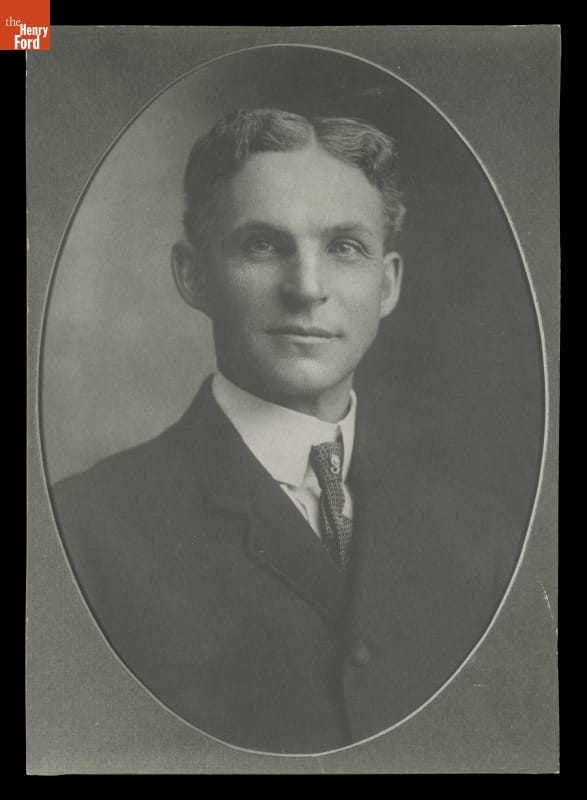
Henry Ford’s first official Ford Motor Company portrait, 1904. / THF97952
Henry Ford did not invent the automobile. But more than any other single individual, he was responsible for transforming the automobile from an invention of unknown utility into an innovation that profoundly shaped the 20th century and continues to affect the 21st. His work at Ford Motor Company revolutionized the automotive industry, setting new standards for production and accessibility.
Innovators change things. They take new ideas—sometimes their own, sometimes other people’s—and develop and promote those ideas until they become an accepted part of daily life. Innovation requires self-confidence, a taste for taking risks, leadership ability, and a vision of what the future should be. Henry Ford had all these characteristics, but it took him many years to develop all of them fully.
Portrait of the Innovator as a Young Man
Ford’s beginnings were perfectly ordinary. He was born on his father’s farm in what is now Dearborn, Michigan, on July 30, 1863. At this time, most Americans were born on farms, and most looked forward to being farmers themselves. Early on, Ford demonstrated some of the characteristics that would make him successful. In his family, he became infamous for taking apart his siblings’ toys as well as his own. He organized other boys to build rudimentary waterwheels and steam engines. He learned about full-size steam engines by becoming acquainted with the engines’ operators and pestering them with questions. He taught himself to fix watches and used the watches themselves as textbooks to learn the basics of machine design. Thus, at an early age, Ford demonstrated curiosity, self-confidence, mechanical ability, the capacity for leadership, and a preference for learning by trial and error. These characteristics would become the foundation of his whole career.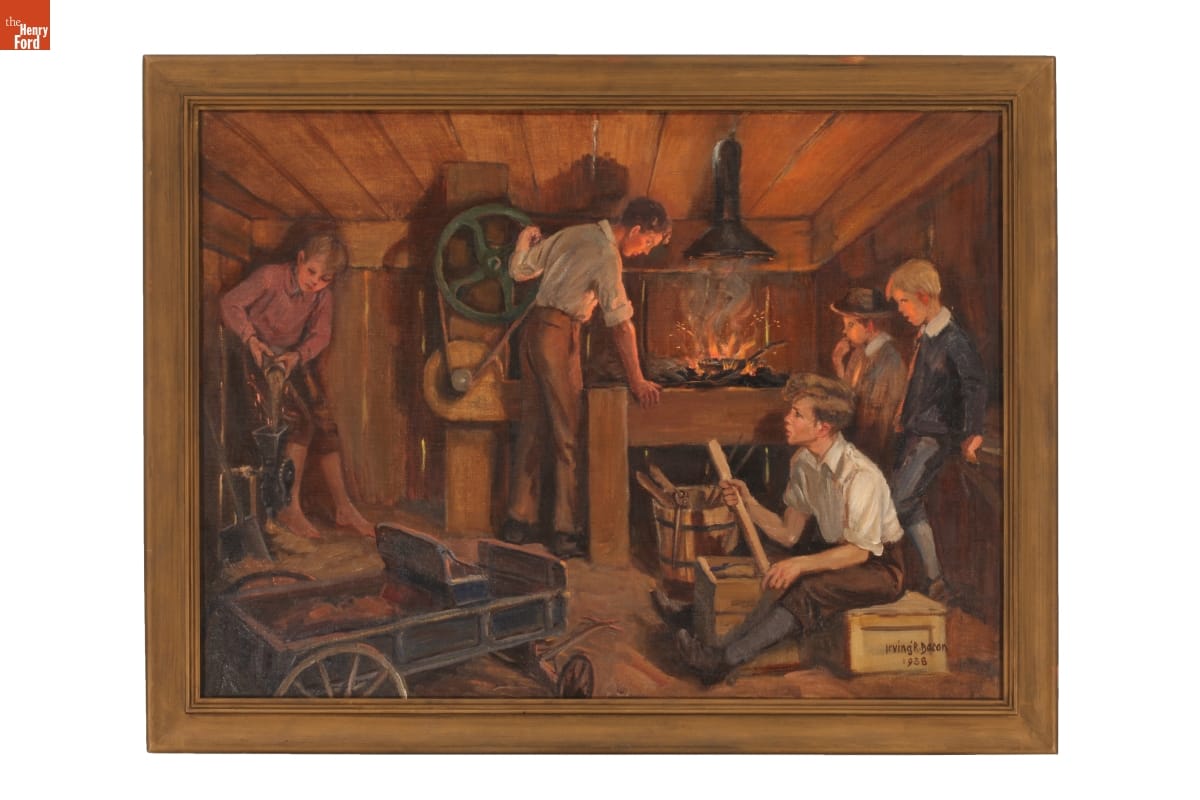
Artist Irving Bacon depicted Henry Ford in his first workshop, along with friends, in this 1938 painting. / THF152920
Ford could simply have followed in his father’s footsteps and become a farmer. But young Henry was fascinated by machines and was willing to take risks to pursue that fascination. In 1879, he left the farm to become an apprentice at a machine shop in Detroit. Over the next few years, he held jobs at several places, sometimes moving when he thought he could learn more somewhere else. He returned home in 1882 but did little farming. Instead, he operated and serviced portable steam engines used by farmers, occasionally worked in factories in Detroit, and cut and sold timber from 40 acres of his father’s land.
By now, Ford was demonstrating another characteristic—a preference for working on his own rather than for somebody else. In 1888, Ford married Clara Bryant, and in 1891 they moved to Detroit. Ford had taken a job as night engineer for the Edison Electric Illuminating Company—another risk on his part, because he did not know a great deal about electricity at this point. He took the job in part as an opportunity to learn.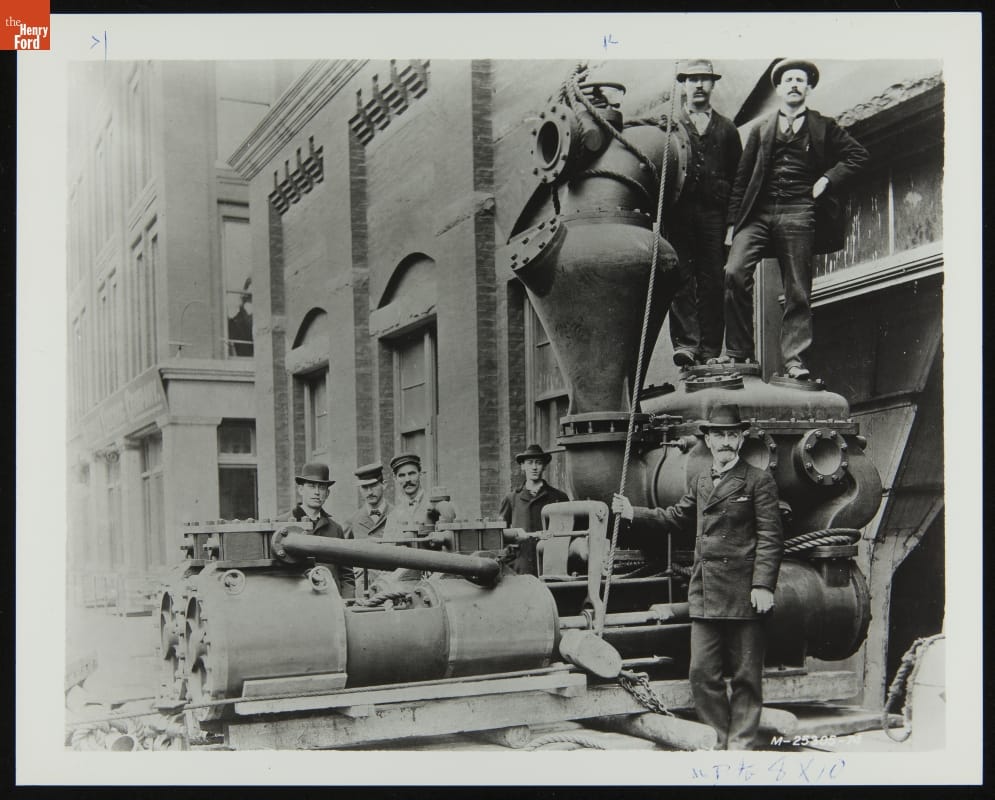
Henry Ford (third from left, in white coat) with other employees at Edison Illuminating Company Plant, November 1895. / THF244633
Early Automotive Experiments: Failure and Then Success
Henry was a skilled student, and by 1896 had risen to chief engineer of the Illuminating Company. But he had other interests. He became one of the scores of other people working in barns and small shops trying to make horseless carriages. Ford read about these other efforts in magazines, copying some of the ideas and adding some of his own, and convinced a small group of friends and colleagues to help him. This resulted in his first primitive automobile, the Quadricycle, completed in 1896. A second, more sophisticated car followed in 1898. These early experiments laid the groundwork for his future endeavors in the automotive industry.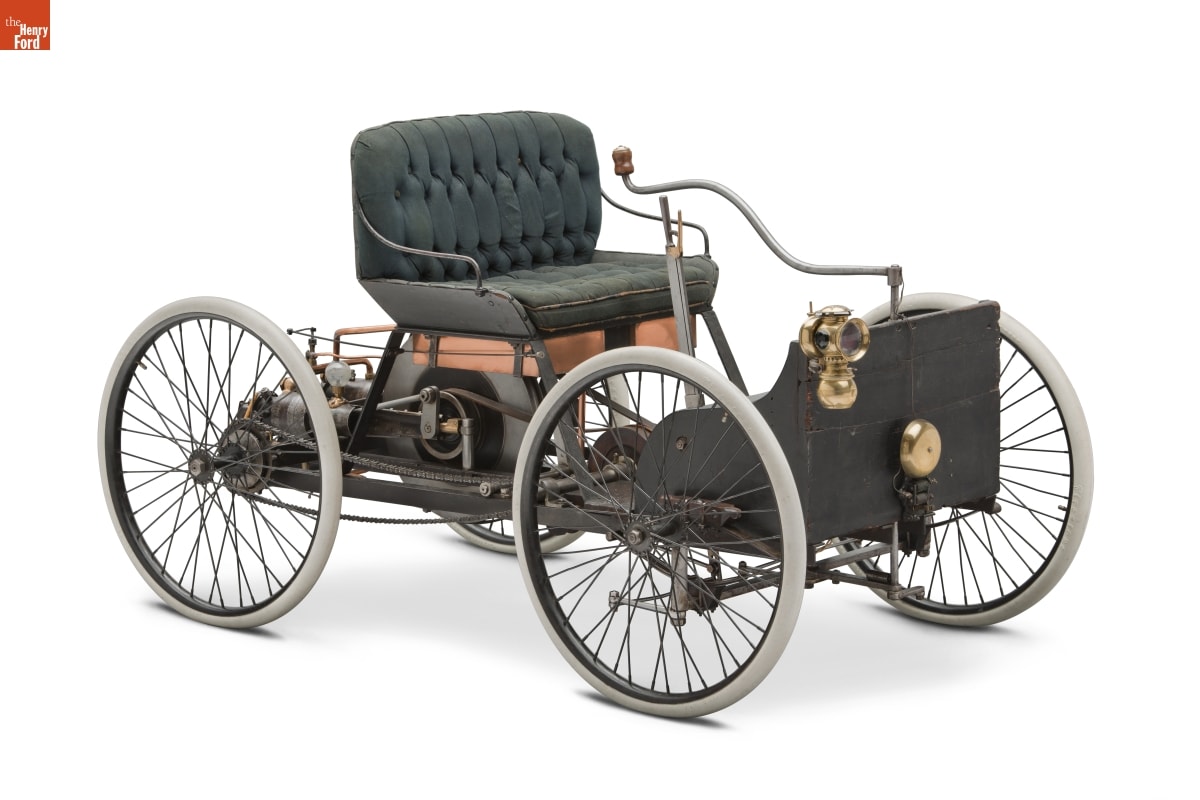
Henry Ford’s 1896 Quadricycle Runabout, the first car he built. / THF90760
Ford now demonstrated one of his most important characteristics—the ability to articulate a vision and convince other people to sign on and help him achieve that vision. He convinced a group of businessmen to back him in the biggest risk of his life—starting a company to make horseless carriages. But Ford knew nothing about running a business, and learning by doing often involves failure. The new company failed, as did a second. His first venture, the Detroit Automobile Company, failed due to the poor quality of its vehicles. Ford tried again, this time with the Henry Ford Company. But disputes over the new company’s direction soon caused Ford and his investors to part ways.
To revive his fortunes, Ford took bigger risks, building and even driving a pair of racing cars. The success of these cars attracted additional financial backers, and on June 16, 1903, just before his 40th birthday, Henry incorporated his third automobile venture, the Ford Motor Company.
The early history of Ford Motor Company illustrates another of Henry Ford’s most valuable traits—his ability to identify and attract outstanding talent. He hired a core of young, highly competent people who would stay with him for years and make Ford Motor Company into one of the world’s great industrial enterprises. He hired a core of young, highly competent people who would stay with him for years, reshaping America’s automotive industry while building Ford Motor Company into one of the world’s great industrial enterprises.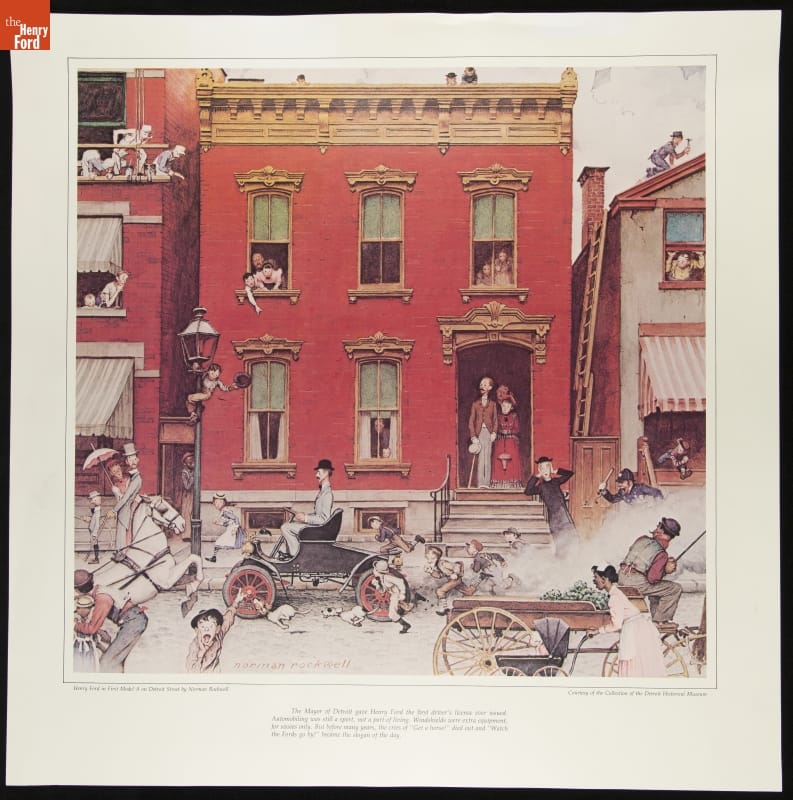
Print of Norman Rockwell's painting, "Henry Ford in First Model A on Detroit Street." / THF288551
The new company’s first car was called the Model A, and a variety of improved models followed. In 1906, Ford’s 4-cylinder, $600 Model N became the best-selling car in the country. But by this time, Ford had a vision of an even better, cheaper “motorcar for the great multitude.” Working with a small group of employees, he came up with the Model T, introduced on October 1, 1908. The Model T was a game-changer, designed to be simple, reliable, and ultimately affordable for the average American.
The Automobile: A Solution in Search of a Problem
As hard as it is for us to believe, in 1908 there was still much debate about exactly what automobiles were good for. We may see them as a necessary part of daily life, but the situation in 1908 was very different. Americans had arranged their world to accommodate the limits of the transportation devices available to them. People in cities got where they wanted to go by using electric street cars, horse-drawn cabs, bicycles, and shoe leather because all the places they wanted to go were located within reach of those transportation modes.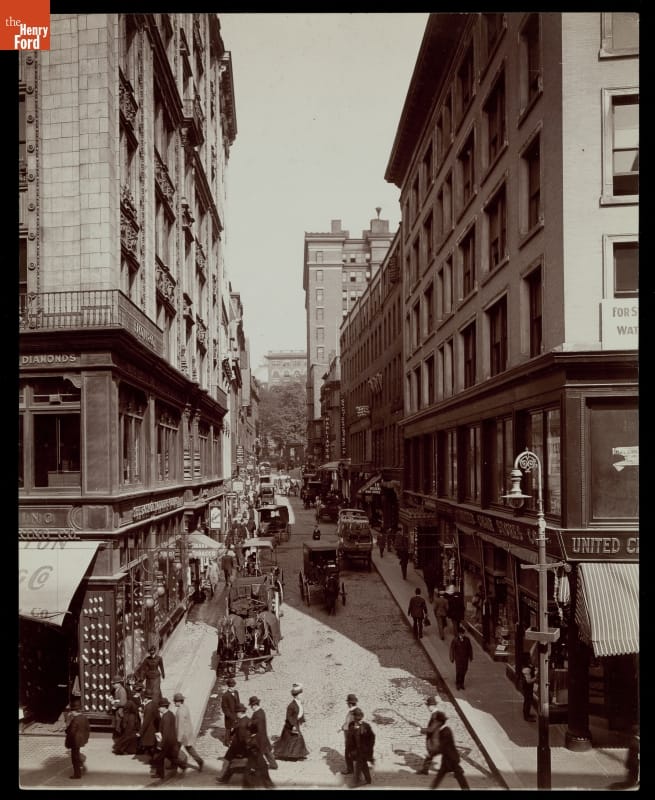
This Boston street scene, circa 1908, shows pedestrians and horse-drawn carriages on the road—but no cars. / THF203438
Most of the commercial traffic in cities still moved in horse-drawn vehicles. Rural Americans simply accepted the limited travel radius of horse- or mule-drawn vehicles. For long distances, Americans used our extensive, well-developed railroad network. People did not need automobiles to conduct their daily activities. Rather, the people who bought cars used them as a new means of recreation. They drove them on joyrides into the countryside. The recreational aspect of these early cars was so important that people of the time divided motor vehicles into two large categories: commercial vehicles, like trucks and taxicabs, and pleasure vehicles, like private automobiles. The term “passenger cars” was still years away. The automobile was an amazing invention, but it was essentially an expensive toy, a plaything for the rich. It was not yet a true innovation.
Henry Ford had a wider vision for the automobile. He summed it up in a statement that appeared in 1913 in the company magazine, Ford Times:
“I will build a motor car for the great multitude. It will be large enough for the family but small enough for the individual to run and care for. It will be constructed of the best materials, by the best men to be hired, after the simplest designs that modern engineering can devise. But it will be so low in price that no man making a good salary will be unable to own one—and enjoy with his family the blessings of hours of pleasure in God’s great open spaces.”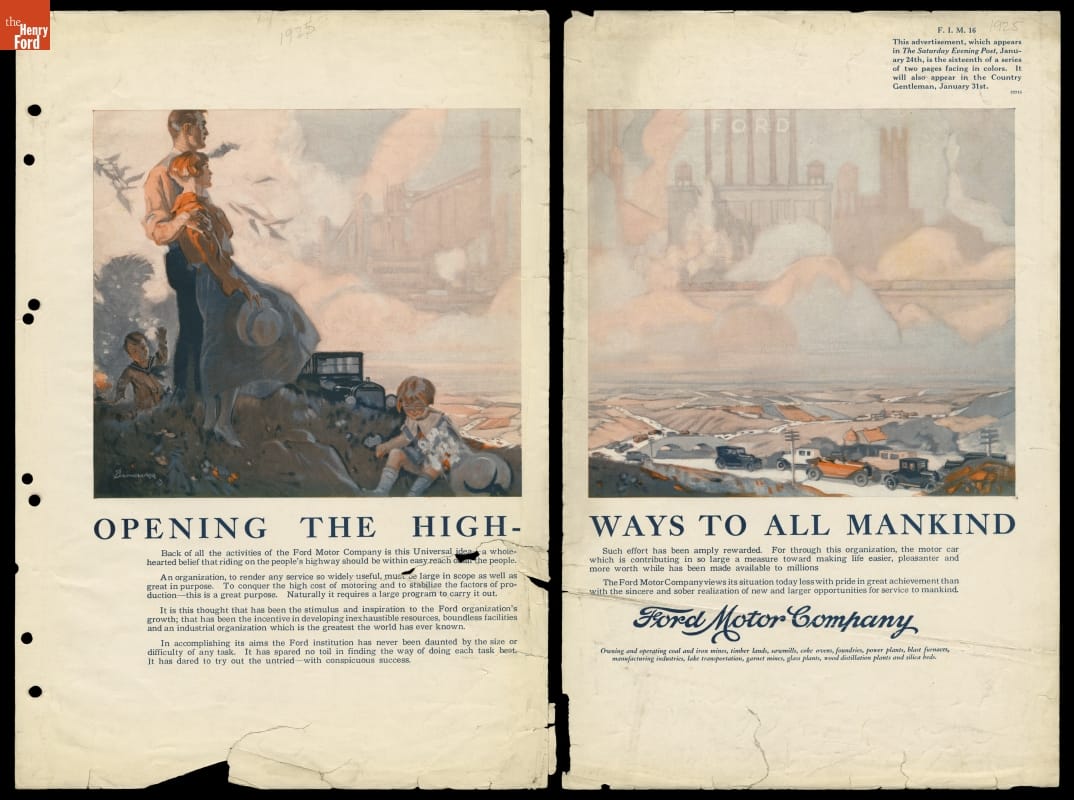
This 1924 Ford ad, part of a series, echoes the vision expressed 11 years earlier by Henry Ford: “Back of all of the activities of the Ford Motor Company is this Universal idea—a wholehearted belief that riding on the people’s highway should be in easy reach of all the people.” / THF95501
It was this vision that moved Henry Ford from inventor and businessman to innovator. To achieve his vision, Ford drew on all the qualities he had been developing since childhood: curiosity, self-confidence, mechanical ability, leadership, a preference for learning by trial and error, a willingness to take risks, and an ability to identify and attract talented people.
One Innovation Leads to Another
Ford himself guided a design team that created a car that pushed technical boundaries. The Model T’s one-piece engine block and removable cylinder head were unusual in 1908 but would eventually become standard on all cars. The Ford’s flexible suspension system was specifically designed to handle the dreadful roads that were then typical in the United States. The designers utilized vanadium alloy steel that was stronger for its weight than standard carbon steel. The Model T was lighter than its competitors, allowing its 20-horsepower engine to give it performance equal to that of more expensive cars. The Model T forever changed the automotive industry and American culture. Its impact can still be felt today.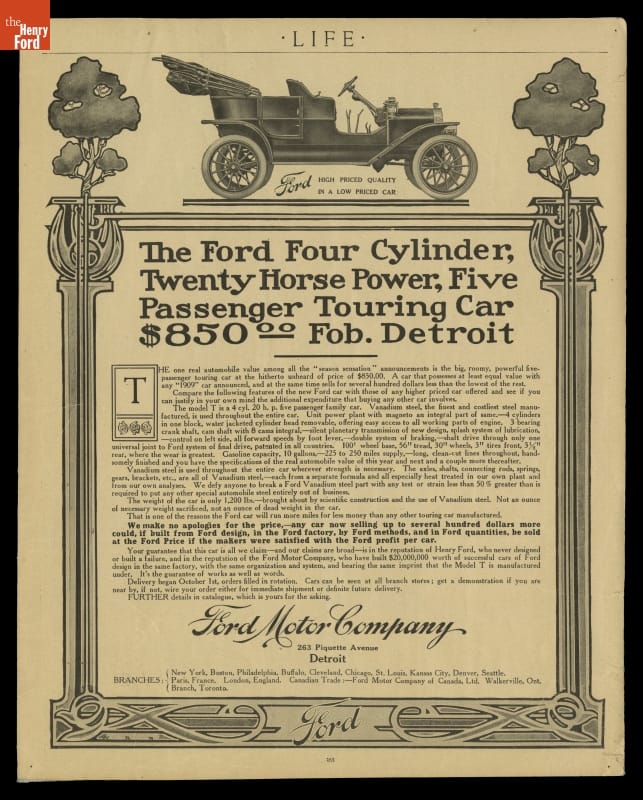
1908 advertisement for the 1909 Ford Model T. In advertisements, Ford Motor Company emphasized key technological features and the low prices of their Model Ts. Ford's usage of vanadium steel enabled the company to make a lighter, sturdier, and more reliable vehicle than other early competitors. / THF122987
The new Ford car proved to be so popular that Henry could easily sell all he could make, but he wanted to be able to make all he could sell. So Ford and his engineers began a relentless drive both to raise the rate at which Model Ts could be produced and to lower the cost of production.
In 1910, the company moved into a huge new factory in Highland Park, a city just north of Detroit. Borrowing ideas from watchmakers, clockmakers, gunmakers, sewing machine makers, and meat processors, Ford Motor Company had, by 1913, developed a moving assembly line for automobiles. But Ford did not limit himself to technical improvements.
When his workforce objected to the relentless, repetitive work that the line entailed, Ford responded with perhaps his boldest idea ever—he doubled wages to $5 per day. With that one move, he stabilized his workforce and gave it the ability to buy the very cars it made. He hired a brilliant accountant named Norval Hawkins as his sales manager. Hawkins created a sales organization and advertising campaign that fueled potential customers’ appetites for Fords. Model T sales rose steadily while the selling price dropped. By 1921, half the cars in America were Model Ts, and a new one could be had for as little as $415.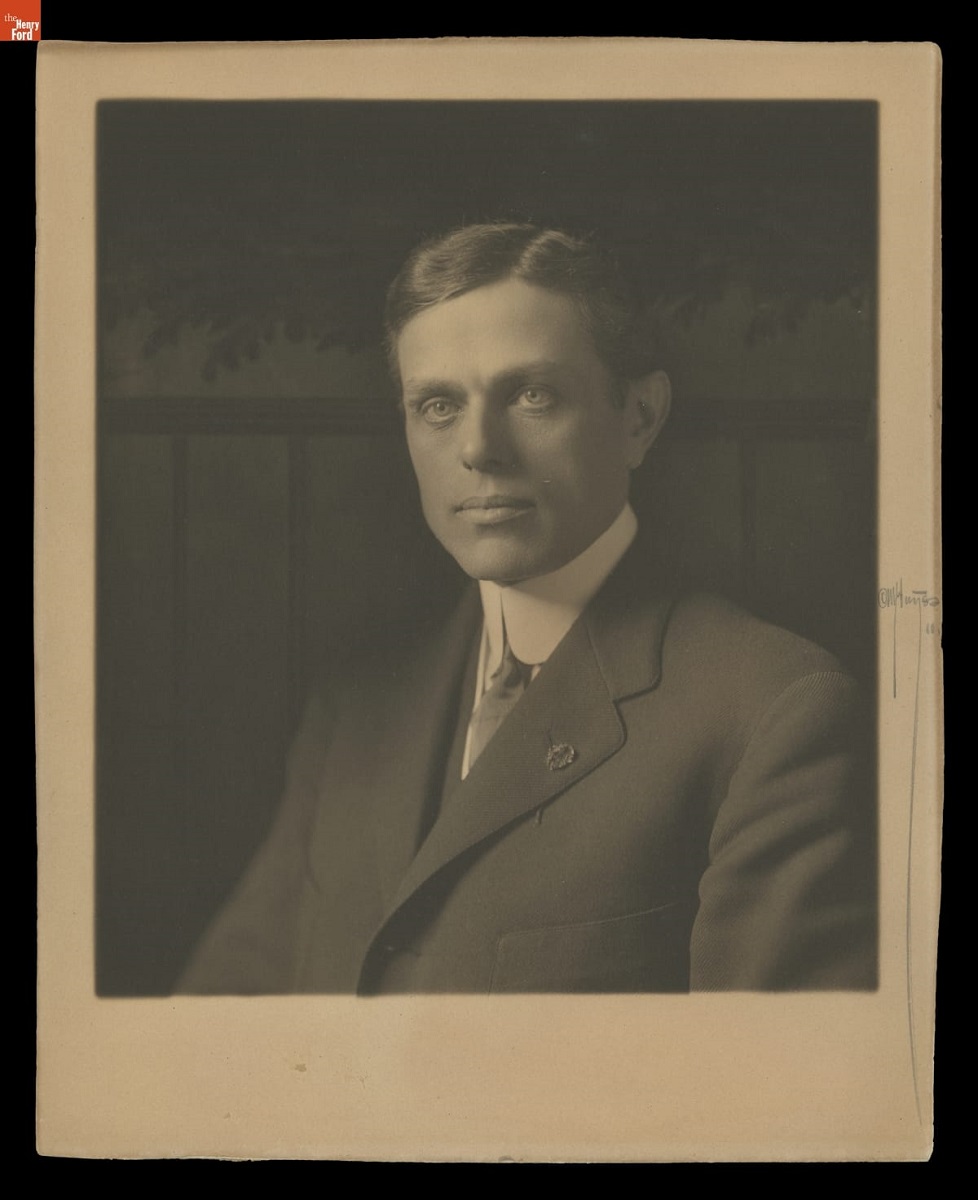
Norval Hawkins headed the sales department at Ford Motor Company for 12 years, introducing innovative advertising techniques and increasing Ford’s annual sales from 14,877 vehicles in 1907 to 946,155 in 1919. / THF145969
Through these efforts, Ford turned the automobile from an invention bought by the rich into a true innovation available to a wide audience. By the 1920s, largely as a result of the Model T’s success, the term “pleasure car” was fading away, replaced by “passenger car.” Ford’s moving assembly line and $5 day ushered in a new era of mass production and affordability. American society itself was transformed as motorists were free to travel where they wanted, when they wanted.
The assembly line techniques pioneered at Highland Park spread throughout the auto industry and into other manufacturing industries as well. The high-wage, low-skill jobs pioneered at Highland Park also spread throughout the manufacturing sector. Advertising themes pioneered by Ford Motor Company are still being used today. Ford’s curiosity, leadership, mechanical ability, willingness to take risks, ability to attract talented people, and vision produced innovations in transportation, manufacturing, labor relations, and advertising. His legacy is preserved at places like Greenfield Village, showcasing his impact on American life and the evolution of the automotive industry.
What We Have Here Is a Failure to Innovate
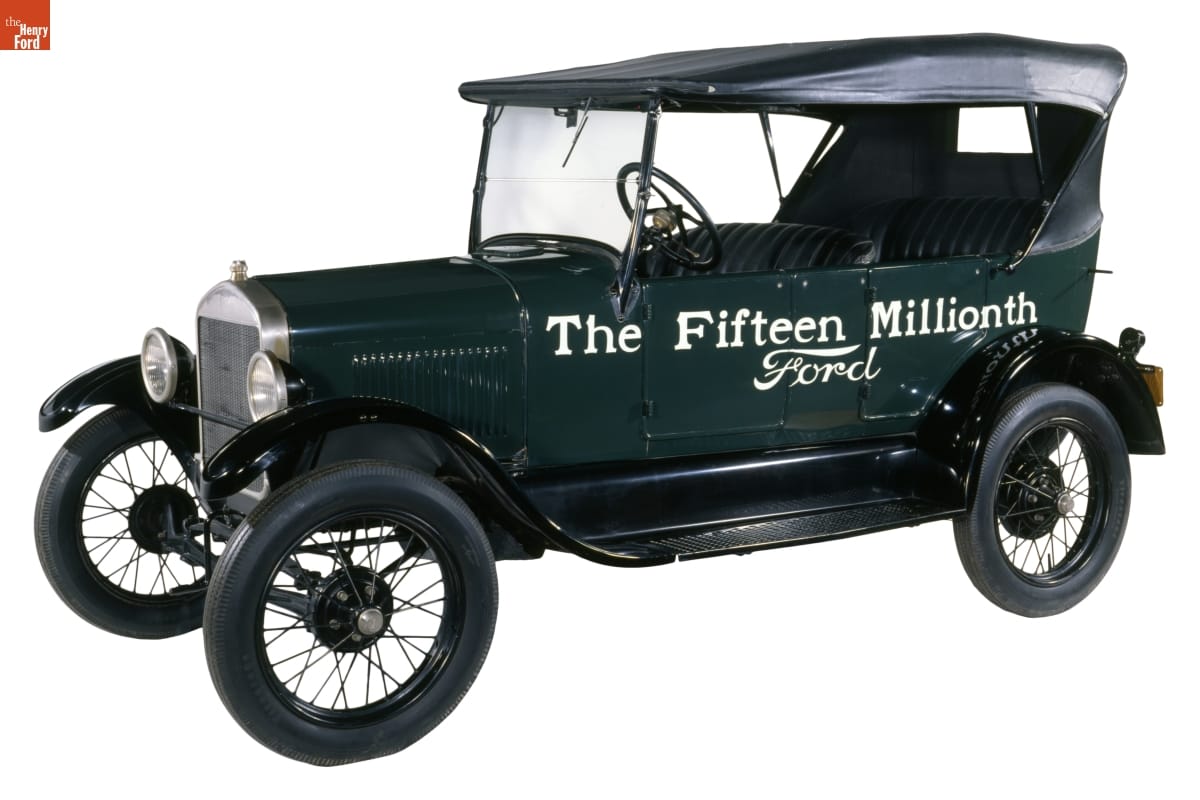
Henry Ford was slow to admit that customers no longer wanted the Model T. However, in 1927, he finally acknowledged that shift, and Henry Ford and his son, Edsel Ford, drove this last Model T—number 15,000,000—off the assembly line at Highland Park. / THF135450
Henry Ford’s great success did not necessarily bring with it great wisdom. In fact, his very success may have blinded him as he looked to the future. The Model T was so successful that he saw no need to significantly change or improve it. He did authorize many detail changes that resulted in lower cost or improved reliability, but there was never any fundamental change to the design he had laid down in 1907.
He was slow to adopt innovations that came from other carmakers, like electric starters, hydraulic brakes, windshield wipers, and more luxurious interiors. He seemed not to realize that the consumer appetites he had encouraged and fulfilled would continue to grow. He seemed not to want to acknowledge that once he started his company down the road of innovation, it would have to keep innovating or else fall behind companies that did innovate. He ignored the growing popularity of slightly more expensive but more stylish and comfortable cars, like the Chevrolet, and would not listen to Ford executives who believed it was time for a new model.
But Model T sales were beginning to slip by 1923, and by the late 1920s, even Henry Ford could no longer ignore the declining sales figures. In 1927, he reluctantly shut down the Model T assembly lines and began the design of an all-new car. It appeared in December 1927 and was such a departure from the old Ford that the company went back to the beginning of the alphabet for a name—it was called the Model A.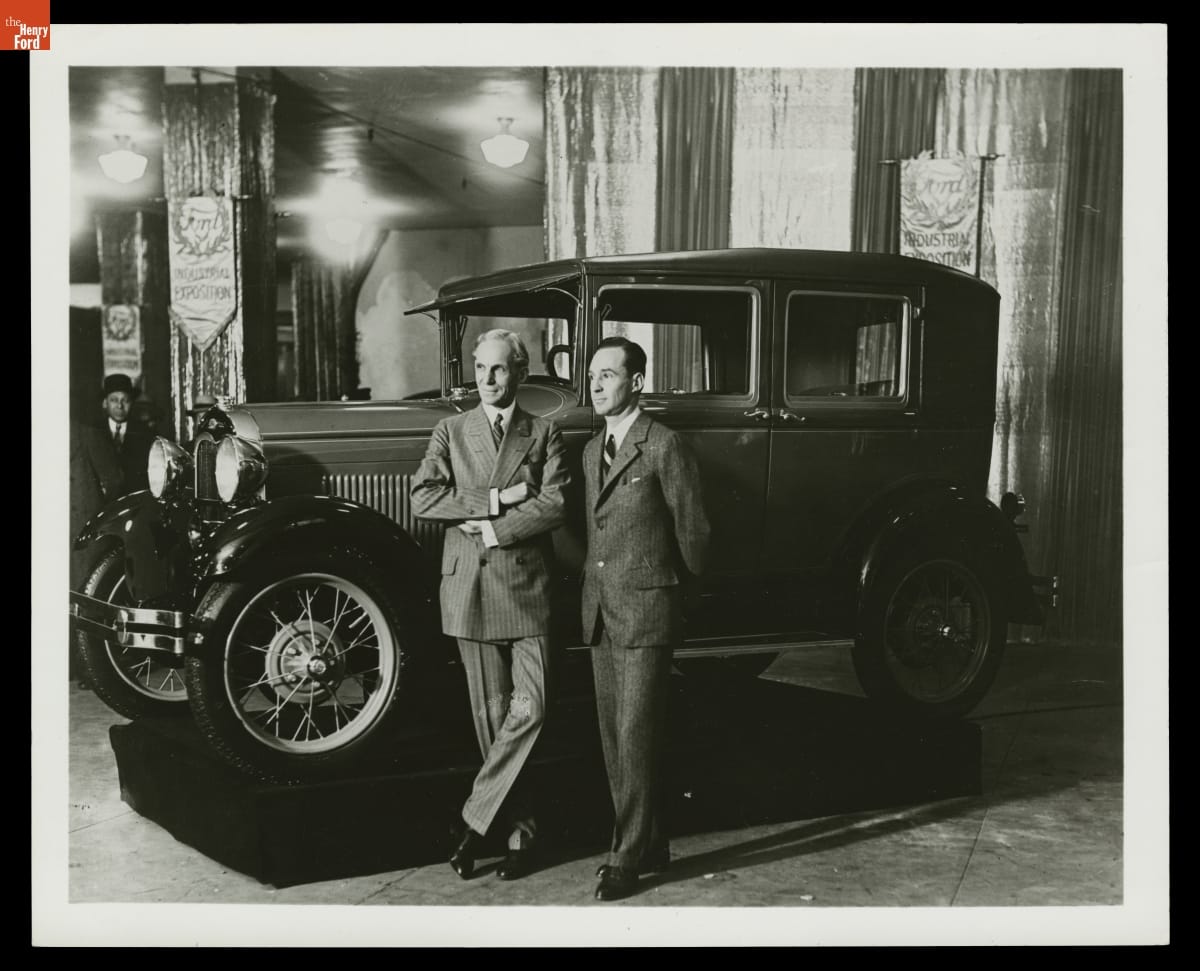
Edsel and Henry Ford introduce the new Model A at the Ford Industrial Exposition in New York in January 1928. Edsel had worked to convince his father to replace the outmoded Model T with something new. / THF91597
One area where Ford did keep innovating was in actual car production. In 1917, he began construction of a vast new plant on the banks of the Rouge River southwest of Detroit. This plant would give Ford Motor Company complete control over nearly all aspects of the production process. Raw materials from Ford mines would arrive on Ford boats, and would be converted into iron and steel, which were transformed into engines, transmissions, frames, and bodies. Glass and tires would be made onsite as well, and all of this would be assembled into completed cars. Assembly of the new Model A was transferred to the Rouge. Eventually the plant would employ 100,000 people and generate many innovations in auto manufacturing. The River Rouge complex became a symbol of Ford's ambition and scale, a testament to his vision for vertically integrated production.
But improvements in manufacturing were not enough to make up for the fact that Henry Ford was no longer a leader in automotive design. The Model A was competitive for only four years before needing to be replaced by a newer model. In 1932, at age 69, Ford introduced his last great automotive innovation, the lightweight, inexpensive V-8 engine. It represented a real technological and marketing breakthrough, but in other areas Fords continued to lag behind their competitors. The Ford factory continued to evolve, but the company faced new challenges in keeping up with changing consumer preferences and technological advancements in the automotive industry.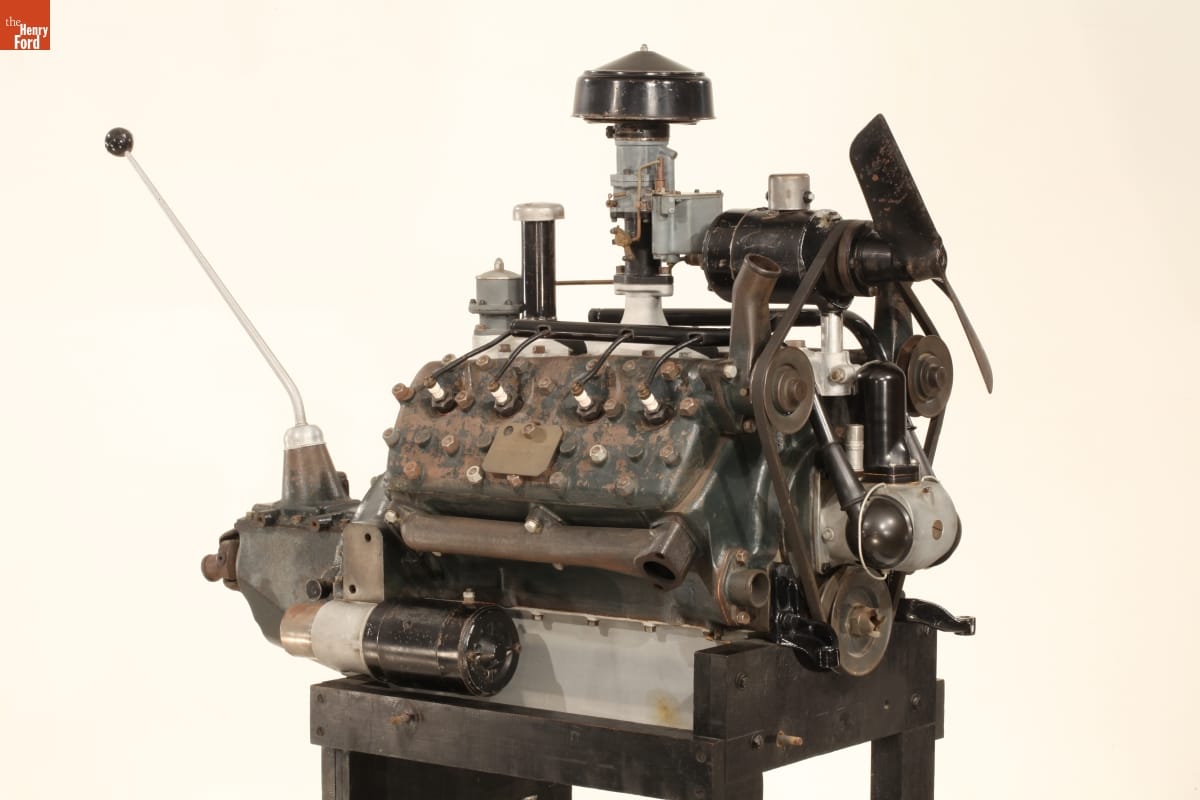
The V-8 engine was Henry Ford’s last great automotive innovation. This is the first V-8 engine produced, which is on exhibit in Henry Ford Museum of American Innovation. / THF101039
By 1936, the company that once sold half of the cars made in America had fallen to third place behind both General Motors and the upstart Chrysler Corporation. By the time Henry Ford died in 1947, his great company was in serious trouble, and a new generation of innovators, led by his grandson Henry Ford II, would work long and hard to restore it to its former glory. Henry’s story is a textbook example of the power of innovation—and the power of its absence. His contributions to the automotive industry and American society are undeniable, but his later resistance to change serves as a cautionary tale.
Bob Casey is former Curator of Transportation at The Henry Ford. This post is adapted from an educational document from The Henry Ford titled “Henry Ford and Innovation: From the Curators.”
Detroit, Michigan, Dearborn, 20th century, 19th century, quadricycle, Model Ts, manufacturing, Henry Ford, Ford Rouge Factory Complex, Ford Motor Company, entrepreneurship, engines, engineering, cars, by Bob Casey, advertising
Driven to Win: Sports Car Performance Center

Jim Hall and Engineers at Chaparral Cars, Midland Texas, Summer, 1968. Hall pioneered some of the modern aerodynamic devices used on race cars. / THF111335
Anatomy of a Winner: Design. Optimize. Implement.
The Sports Car Performance Center section of our new racing exhibit, Driven to Win: Racing in America Presented by General Motors, is racing research and development on steroids. Passion and fortitude come standard.
The modern race shop encompasses a combination of scientific research, computer-aided design and engineering, prototyping, product development and testing, fabrication, and manufacturing. Here you can go behind the scenes to see how experts create winning race cars, using their knowledge in planning and problem-solving.
You can learn about key elements for achieving maximum performance through an open-ended exploration of components of the cars on display, as well as through other activities. STEM (science, technology, engineering, and mathematics) principles are a key focus here.
2016 Ford GT Race Car
(On loan from Ford Motor Company)
THF176682
This is the actual car that won the LMGTE Pro class at the 2016 24 Hours of Le Mans. The win was historic because it happened on the 50th anniversary of Ford’s first Le Mans victory in 1966, but over that half-century, racing technology advanced enormously, and the engine is half the size (a 3.5-liter, all-aluminum V-6 compared with a 7-liter, cast-iron V-8). But twin turbochargers (vs. naturally aspirated intake), direct fuel injection (vs. carburation), and electronic engine controls (vs. all mechanical) gave the GT engine almost 650 horsepower, versus slightly over 500 horsepower for the Mark IV.
Computer-aided design and engineering, aerodynamic innovations to maximize downforce and minimize drag, and electronic controls for the engine and transmission all combine to make the 2016 Ford GT a much more advanced race car, as you would expect 50 years on. The technology and materials advances in the GT’s brakes, suspension and tires, combined with today’s aerodynamics, make its handling far superior to its famous ancestor.
2001 C5-R Corvette
(On loan from General Motors Heritage Center)
THF185965
You can’t talk about American sports car racing without America’s sports car. The Chevrolet Corvette was in its fifth styling generation when the race version C5-R debuted in 1999. The Corvette Racing team earned 35 victories with the C5-R through 2004, including an overall victory at the 24 Hours of Daytona in 2001. This is the car driven by Ron Fellows, Johnny O'Connell, Franck Freon, and Chris Kneifel in that Daytona win.
Additional Artifacts

THF185968
Beyond the cars, you can see these artifacts related to sports car performance in Driven to Win.
Dig Deeper

Bruce McLaren and Chris Amon earned Ford its first win at Le Mans with the #2 GT40 on June 19, 1966. Ford celebrated that victory with another one on June 19, 2016—exactly 50 years later. / lemans06-66_083
Learn more about sports car performance with these additional resources from The Henry Ford.
- Listen as Raj Nair, President and COO of Multimatic, and Henry Ford III, former Global Marketing Manager for Ford Performance, describe their experiences building, testing and racing the 2016 Ford GT—or watch a longer conversation with Raj Nair, Ford Performance’s Mark Rushbrook, and the driver who took the 2016 Ford GT on its final lap across the 24 Hours of Le Mans finish line, Joey Hand.
- Watch Jim Hall explain how he became one of the first to realize the advantages of utilizing aerodynamic downforce to help keep race cars on the road.
- Hear from Carroll Shelby on his approach to designing and building high-performance automobiles.
- Listen as Mario Andretti describes the mystique of the 24 Hours of Le Mans.
- Hear the story of Ford’s 1960s Le Mans campaign as told by Carroll Shelby, Dan Gurney, A.J. Foyt, and others.
- View the trophy given to Ford at Le Mans in 1966.
- See photos from Ford’s successful 1967 run at Le Mans.
- Learn how Bobby Unser developed a quick, inexpensive method of measuring airflow under race cars.
- 2012 Ford Fiesta Rally Car, Driven by Ken Block in "Gymkhana Five"
- National Hot Rod Association Top Fuel Competition Drag Racing Car, Driven by Gary Ormsby in the 1989 and 1990 NHRA Seasons, 1989
- 2018 Chevrolet Camaro ZL1 1LE. On Loan from General Motors Heritage Center.
- Barney Korn: Tether Car Craftsman
making, technology, cars, engineering, race cars, Henry Ford Museum, Driven to Win, design, racing

